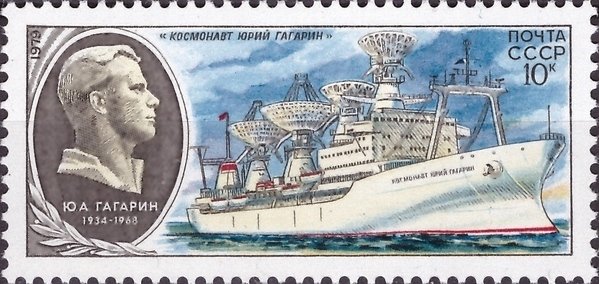Stamp: Vessel "Cosmonaut Yuri Gagarin" (Soviet Union, USSR 1979)
Vessel "Cosmonaut Yuri Gagarin" (Soviet Union, USSR 1979)
25 December (Soviet Union, USSR ) within release Ships goes into circulation Stamp Vessel "Cosmonaut Yuri Gagarin" face value 10 Russian kopek
| Stamp Vessel "Cosmonaut Yuri Gagarin" in catalogues | |
|---|---|
| Michel: | Mi:SU 4910 |
Stamp is horizontal format.
Also in the issue Ships:
- Stamp - Vessel "Vulcanolog" (it means "Volcano researcher") face value 1;
- Stamp - Vessel "Professor Bogorov" face value 2;
- Stamp - Vessel "Ernst Krenkel" face value 4;
- Stamp - Vessel "Cosmonaut Vladislav Volkov" face value 6;
- Stamp - Vessel "Cosmonaut Yuri Gagarin" face value 10;
- Stamp - Vessel "Academik Kurchatov" face value 15;
Stamp Vessel "Cosmonaut Yuri Gagarin" it reflects the thematic directions:
A ship is a large watercraft that travels the world's oceans and other sufficiently deep waterways, carrying passengers or goods, or in support of specialized missions, such as defense, research and fishing. Historically, a "ship" was a sailing vessel with at least three square-rigged masts and a full bowsprit. Ships are generally distinguished from boats, based on size, shape and load capacity.
Communication is commonly defined as the transmission of information. Its precise definition is disputed and there are disagreements about whether unintentional or failed transmissions are included and whether communication not only transmits meaning but also creates it. Models of communication are simplified overviews of its main components and their interactions. Many models include the idea that a source uses a coding system to express information in the form of a message. The message is sent through a channel to a receiver who has to decode it to understand it. The main field of inquiry investigating communication is called communication studies.
Science is a systematic discipline that builds and organises knowledge in the form of testable hypotheses and predictions about the universe.Modern science is typically divided into two or three major branches: the natural sciences (e.g., physics, chemistry, and biology), which study the physical world; and the behavioural sciences (e.g., economics, psychology, and sociology), which study individuals and societies.The formal sciences (e.g., logic, mathematics, and theoretical computer science), which study formal systems governed by axioms and rules, are sometimes described as being sciences as well; however, they are often regarded as a separate field because they rely on deductive reasoning instead of the scientific method or empirical evidence as their main methodology. Applied sciences are disciplines that use scientific knowledge for practical purposes, such as engineering and medicine
An astronaut (from the Ancient Greek ἄστρον (astron), meaning 'star', and ναύτης (nautes), meaning 'sailor') is a person trained, equipped, and deployed by a human spaceflight program to serve as a commander or crew member aboard a spacecraft. Although generally reserved for professional space travelers, the term is sometimes applied to anyone who travels into space, including scientists, politicians, journalists, and tourists




